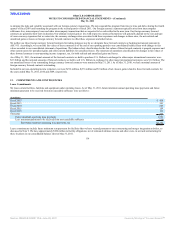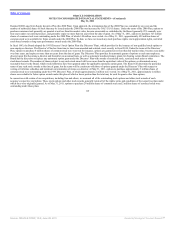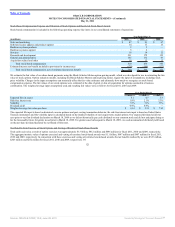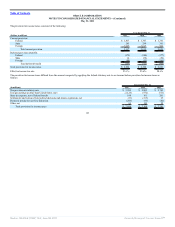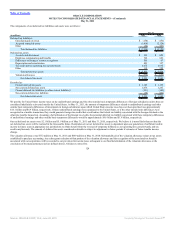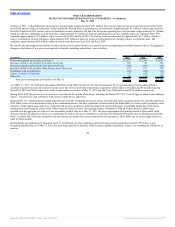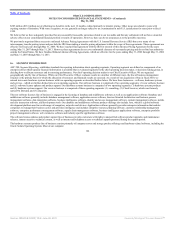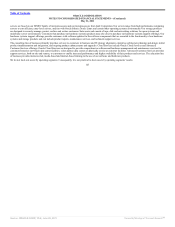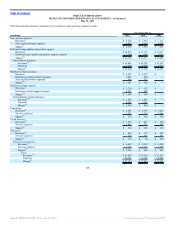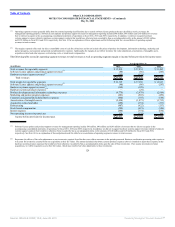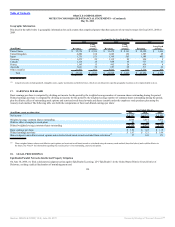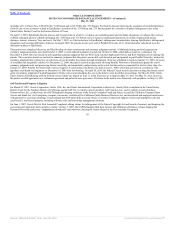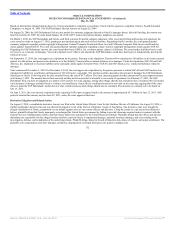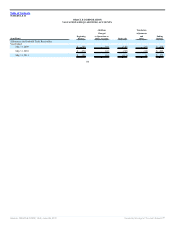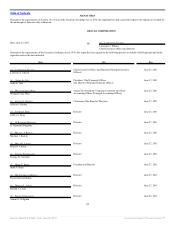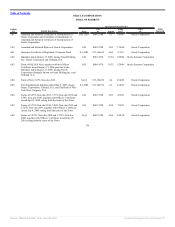Oracle 2010 Annual Report Download - page 130
Download and view the complete annual report
Please find page 130 of the 2010 Oracle annual report below. You can navigate through the pages in the report by either clicking on the pages listed below, or by using the keyword search tool below to find specific information within the annual report.
Table of Contents
ORACLE CORPORATION
NOTES TO CONSOLIDATED FINANCIAL STATEMENTS—(Continued)
May 31, 2011
$285 million ($181 million net of offsetting tax benefits) in the next 12 months, related primarily to transfer pricing. Other issues are related to years with
expiring statutes of limitation. With some exceptions, we are generally no longer subject to tax examinations in non-U.S. jurisdictions for years prior to fiscal
1998.
We believe that we have adequately provided for any reasonably foreseeable outcomes related to our tax audits and that any settlement will not have a material
adverse effect on our consolidated financial position or results of operations. However, there can be no assurances as to the possible outcomes.
We previously negotiated three successive unilateral Advance Pricing Agreements with the U.S. Internal Revenue Service (IRS) that cover many of our
intercompany transfer pricing issues and preclude the IRS from making a transfer pricing adjustment within the scope of these agreements. These agreements are
effective for fiscal years through May 31, 2006. We have reached final agreement with the IRS for renewal of this Advance Pricing Agreement for the years
ending May 31, 2007 through May 31, 2013. However, these agreements do not cover substantial elements of our transfer pricing and do not bind tax authorities
outside the United States. We have finalized bilateral Advance Pricing Agreements, which are effective for the years ending May 31, 2002 through May 31, 2006
and May 31, 2007 through May 31, 2013.
16. SEGMENT INFORMATION
ASC 280, Segment Reporting, establishes standards for reporting information about operating segments. Operating segments are defined as components of an
enterprise about which separate financial information is available that is evaluated regularly by the chief operating decision maker, or decision making group, in
deciding how to allocate resources and in assessing performance. Our chief operating decision maker is our Chief Executive Officer. We are organized
geographically and by line of business. While our Chief Executive Officer evaluates results in a number of different ways, the line of business management
structure is the primary basis for which the allocation of resources and financial results are assessed. As a result of our acquisition of Sun in fiscal 2010, we
entered into a new hardware systems business with two operating segments as described further below. We have three businesses—software, hardware systems
and services—which are further divided into seven operating segments. Our software business is comprised of two operating segments: (1) new software licenses
and (2) software license updates and product support. Our hardware systems business is comprised of two operating segments: (1) hardware systems products
and (2) hardware systems support. Our services business is comprised of three operating segments: (1) consulting, (2) Cloud Services, which was formerly
named On Demand, and (3) education.
The new software licenses line of business is engaged in the licensing of database and middleware software as well as our applications software. Database and
middleware software generally includes database management software, application server software, Service-Oriented Architecture and business process
management software, data integration software, business intelligence software, identity and access management software, content management software, portals
and user interaction software, and development tools. Our database and middleware software product offerings also include Java, which is a global software
development platform used in a wide range of computers, networks and devices. Applications software generally provides enterprise information that enables
companies to manage their business cycles and provides intelligence and includes enterprise resource planning software, customer relationship management
software, enterprise performance management software, supply chain management software, business intelligence applications software, enterprise portfolio
project management software, web commerce software and industry-specific applications software.
The software license updates and product support line of business provides customers with rights to unspecified software product upgrades and maintenance
releases, internet access to technical content, as well as internet and telephone access to technical support personnel during the support period.
The hardware systems products line of business consists primarily of computer server and storage product offerings and hardware-related software, including the
Oracle Solaris Operating System. Most of our computer
126
Source: ORACLE CORP, 10-K, June 28, 2011 Powered by Morningstar® Document Research℠


